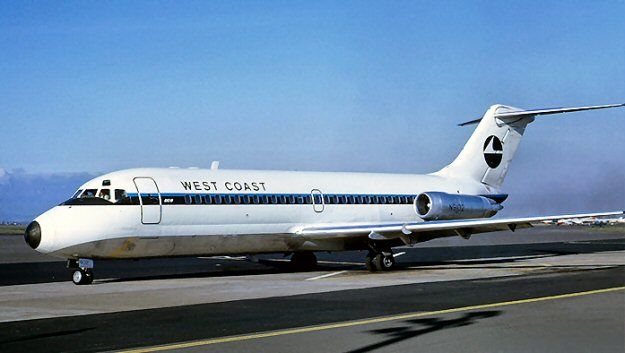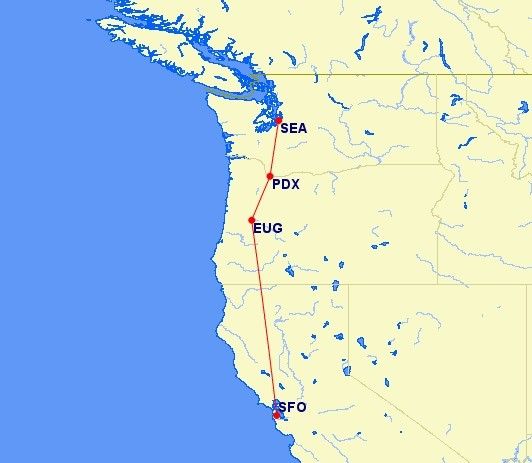West Coast Airlines Flight 956 was a scheduled commercial flight from San Francisco to Seattle, which crashed on October 1st, 1966, in the state of Oregon. Eighteen passengers and crew lost their lives in the accident, which occurred at the end of the aircraft's first week in service. The impact and subsequent post-impact fire destroyed the plane, a new McDonnell Douglas DC-9.
A new aircraft on a routine flight
It was Saturday, October 1st, 1966, and West Coast Airlines Flight 941 had just flown down the western coast of the United States on a routine scheduled flight from Seattle (SEA) to San Francisco (SFO), with intermediate stops at Portland (PDX) and Eugene (EUG), both located in the state of Oregon.
Having been on the ground at San Francisco International Airport for an hour, the aircraft was ready to return to Seattle as Flight 956, following the same route as the southbound flight earlier that afternoon.
Flight 956 was operated that day by McDonnell Douglas DC-9 series 14, with the registration N9101. This aircraft was brand new to West Coast Airlines, having been delivered by the manufacturer to the airline just 15 days earlier. Following pre-entry into service checks, the aircraft had only entered commercial service with the carrier just six days previously, on Monday, September 26th, 1966.
Crewing Flight 956 that day were two captains and a first officer. The flight was a route qualification flight for its captain, Donald Alldredge, who had over 18,900 flying hours, but only seventeen in the DC-9. He was operating the flight the under the supervision of one of West Coast's training captains, Charles Warren, who had 21,800 hours, but only fifty on the DC-9.
The first officer, Pete Lebusky, sitting in the jump seat, had over 9,500 hours, with only nine on the DC-9. All three had completed recent proficiency checks. The operating captain and first officer had undergone their check flights on Thursday, September 29th, just two days before taking the controls of Flight 956.
Meanwhile, the training captain's proficiency check was performed on September 20th. The other two crew members were flight attendants working in the passenger cabin.
Timeline of events
With passengers boarded and doors closed, West Coast Airlines Flight 956 was pushed back from its gate in San Francisco at around 18:30 that Sunday evening. The flight took off at 18:44 local time for its flight north, initially to Eugene.
Having landed in Eugene at 19:34 and following a rapid turnaround, the aircraft was airborne again at 19:52. For this leg of the multi-stop journey, there were 13 passengers along with the five crew onboard N9101.
Given the short distance between Eugene and Portland airports (106 miles), Flight 956 was cleared to a cruising altitude of just 12,000 ft (3,660) following Instrument Flight Rules (IFR) on its brief flight, which would subsequently turn out to be the aircraft's last. Once reaching the cruising altitude, the crew later requested and received clearance to climb to 14,000 ft (4,720 m).
Following radar vectors provided by air traffic controllers based at Seattle ATC center, at 20:04 (just twelve minutes after take-off from Eugene), Flight 956 was instructed to commence its descent towards Portland. The crew of Flight 956 acknowledged this transmission which instructed them to descend from their assigned cruising altitude to 9,000 feet (2,740 m).
Approximately one minute later, at 20:04, the controller following Flight 956 advised the crew to expect a landing on runway 28R at Portland International Airport. The controller then instructed the flight to turn right onto a heading of 300 degrees.
After initially questioning the direction of the turn, as a right turn would take them closer to the mountains, the crew acknowledged this request, transmitting, "right turn to three zero zero, roger."
The crew of Flight 956 was then requested to report when established on a heading of 300 degrees. After a short delay and repeating the request, the crew of Flight 956 responded, transmitting, "Nine five six, wilco."
Radar contact lost
Radar contact was lost with the flight at around 20:10 while it was in the right turn passing through an estimated heading of 240 to 260 degrees. With no further radio transmissions heard from Flight 956, the controller initiated the accident notification procedures at 20:15. A United States Air Force F-106 Delta Dart fighter jet, along with an HU-16 Albatross seaplane based at Portland Air Base, were dispatched to search for any signs of the missing flight.
However, Flight 956's disappearance occurred more than an hour after sunset, so it was already dark. Furthermore, the cloud base was reported to be at 2,900 feet (880 m), with the weather consisting of rain showers in the general vicinity of where Flight 956 was last reported.
The wreckage was discovered the next day
On the afternoon of Sunday, October 2nd, 1966, searchers found the wreckage of Flight 956. The crash site was in an unpopulated section of the Mount Hood National Park, approximately ten miles (16 km) west-southwest of Mount Hood.
The wreckage of N9101 was located on the eastern slope of a 4,090 feet (1,250 m) ridge in a rugged, hard-to-reach area of the Salmon Mountain complex, at an elevation of 3,830 feet (1,170 m). Inspection of the crash site showed that the aircraft's attitude as it impacted the mountain was 30 degrees right bank, in a nose-up pitch attitude on a heading of 265 degrees.
After shearing numerous large fir trees, the aircraft struck the 30-35 degree upslope and slid uphill approximately 150 feet (45 m). The main wreckage came to rest at a height of 3,890 feet (1,190 m). Following the impact, a significant post-crash fire engulfed the plane and destroyed much of the wreckage.
However, despite the severe fire damage, all of the extremities of the aircraft, such as the tail structure and wings, could be accounted for by the investigators. The plane's landing gear was retracted at impact, and no evidence of in-flight structural failure, fire, or explosion could be found.
The aircraft was equipped with both a flight data recorder and a cockpit voice recorder. Although both were recovered from the wreckage, only the flight data recorder could provide usable information.
Investigation and findings
With the lack of evidence, following the large-scale destruction of the aircraft following the impact and subsequent post-crash fire, the National Transport Safety Board (NTSB) could not determine any specific cause for the loss of Flight 956. However, in the process of its investigation, and with what evidence it could recover, the NTSB made the following six findings -
- The aircraft was airworthy, and the pilots were properly certified.
- There was no mechanical failure of the aircraft, its systems, powerplants, or components.
- The flight was cleared to and acknowledged an assigned altitude of 9,000 feet (2,740 m) but continued its descent to 4,000 ft.
- The aircraft was being flown on autopilot.
- The flight descended normally to approximately 4,000 feet (1,220 m) and leveled off, although its rate of descent increased from 1,800 feet per minute to 3,500 feet per minute during this final phase of the flight.
- An abrupt climb was initiated two seconds before impact.
The official report concluded by stating that "the descent of the aircraft below its clearance limit and below that of surrounding obstructing terrain, but the Board has been unable to determine the cause of such descent."
Summary
Although the official investigation could not determine, beyond a reasonable doubt, the cause of the accident, speculation was made at the time proposing a variety of possible causes that resulted in the loss of Flight 956 and all those onboard.
Such theories included that the pilots were confused with the assigned altitude clearance on the descent. The autopilot was, after all, set to level off at 4,000 ft rather than the instructed 9,000 ft, and the plane leveled off at this height about two minutes before impact.
Another theory was that the collective inexperience of the flight crew on the DC-9 may have been to blame. There have additionally been other accidents that involved the flight crew misreading altimeters (such as United Airlines Flight 389, resulting in the first hull loss of a Boeing 727) that may also have been a contributory factor.
Whatever the cause, the accident resulted in the total loss of a brand-new aircraft, along with 18 lives. Given the remoteness of the crash site, much of the wreckage reportedly remains at the location to this day.
The accident resulted in the first total loss of a DC-9, which had only entered commercial service with Delta Air Lines in December 1965, just nine months previously.
Sources: Aviation Safety Network, NTSB,




